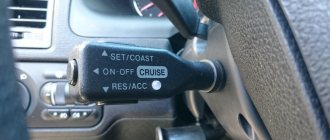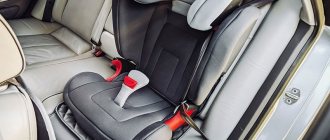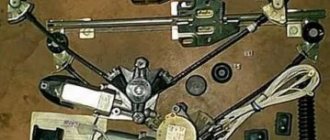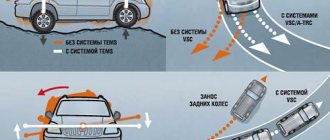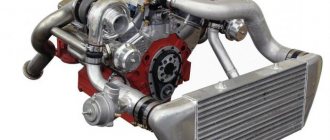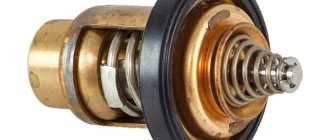Types of automatic transmission selectors
What is an automatic transmission selector and where is it located? Externally, the selector resembles a gear shift lever in a manual transmission with additional buttons. The automatic transmission gear selector has no lateral movement left/right; it can only move up/down.
Depending on the design of the control lever and the interior of the cabin, manufacturers place the gear shift lever in different places. According to their location, automatic transmission selectors are divided into the following types:
- Steering column type.
- Push-button located on the instrument panel.
- Floor.
Automatic transmission gear selector: types, disassembly and repair
Purchase scanners for automatic transmissions from my website akppoff.ru Diagnose and repair it yourself.
Almost every modern automobile manufacturer has cars with automatic transmissions installed on them, in which the driver changes gears through the automatic transmission selector. The automatic transmission is easy to operate, especially for novice drivers, and is designed for city driving with its daily traffic jams and frequent braking and acceleration.
Thanks to the automatic gearbox, an independent change in the gear ratio in the transmission is provided, without the direct participation of the driver, depending on the current driving conditions.
Automatic transmission selector, what is it?
If we describe what an automatic transmission selector is, then it is an element for controlling the operating modes of an automatic transmission; in the standard version it is a lever with a button. By moving the lever, you can select the vehicle's driving mode (park, neutral, reverse and forward)
Types of automatic transmission selectors
Automakers make their own changes to the design and place the gear selector in different parts of the driver’s working area:
Resource of automatic transmission, mileage and service life of automatic transmission
Features of the location of the automatic transmission selector
The location of the gearbox selector paddle is typical for cars manufactured in the USA before the 90s. This allowed two more passengers to sit in front, due to the one-piece long seat, and fit compactly into the interior of the steering column area.
The push-button switch option is found on Land Rover, Honda and Chrysler vehicles from the mid-20th century, a characteristic feature of minivans and high-riding cars.
The floor option is the most popular and familiar in Europe.
Selector protection against accidental movement
The gear selector is protected by several mechanisms, but can also fail:
Automatic transmission selector repair
Untimely maintenance of an automatic automatic transmission will lead to a decrease in the vehicle's handling qualities, and accidents may occur.
More often than not, automatic transmissions break down not so much because of a long service life, but because of untimely maintenance, savings on spare parts and working fluids, inexperience and carelessness of the driver.
Practice proves that it is easier to repair the electronic control unit and gear selector than to remove the device itself from the car. If you lack experience in disassembling automobile units, refrain from dismantling and entrust the matter to specialists from service centers specializing in automatic transmissions.
The lack of specialized computer equipment will not solve the problem by erasing the error code, as many do; such methods will not eliminate the cause of the breakdown.
Repair begins with diagnostics, then the lever is removed, a thorough visual inspection and troubleshooting of parts is carried out, contacts are washed, parts are lubricated and cleaned, and broken parts are replaced. Reassembly is carried out, or a new part is purchased due to non-repairability.
Removing the automatic transmission selector
Removing the selector from the car may vary depending on the make and model of the car; the gear shift device is much more complex than on a manual transmission.
Features of the location of the automatic transmission selector
Convenient placement of the device under the steering column allows you to change gears without interference. Thanks to this interior design, there is an additional opportunity to use a solid seat in front, where a third passenger can fit. Similar designs were widely used in American-made cars at the end of the last century.
Push-button selectors were actively used in cars equipped with high-slung seats. In the fifties, such selectors were very popular and were installed in automatic machines of minibuses, minivans, jeeps and other models of that time. The main manufacturers of cars with push-button selector for automatic transmissions at that time were such well-known companies as Chrysler, Honda and some Japanese brands.
Modern vehicles manufactured in Europe and Japan are most often equipped with floor-mounted automatic gearshift levers. Here, the selectors are located in the middle of the cabin between the driver's seat and the front passenger seat.
Which handle is better?
Since the middle of the last century, automatic transmission selectors have acquired two types of design. American cars often used a layout with a steering column positioned handle. The selector was attached under the steering wheel, and from it rods went to the automatic transmission, which was located longitudinally behind the engine in a special tunnel approximately between the legs of the driver and passenger. The absence of a selector on the central tunnel made it possible to free up additional space in the car interior to accommodate one more passenger. Therefore, in front, the Americans placed wide sofas for three people, which had enviable functionality. The sofa was also in Soviet cars, such as the Pobeda and Volga GAZ-21, made according to the American fashion of those years. However, instead of automatic transmissions, they had conventional manual ones, but with a steering column-mounted selector.
Question and answer Why does the oil in a car’s gearbox last a long time, but in the engine only 15 thousand km? The long handle under the steering wheel also had disadvantages. During active taxiing, it was possible to touch it with your hands and knock the “D” mode into neutral or, worse, into reverse “R”. Then an inattentive driver could cause serious damage to the transmission.
The European School of Automotive Engineering has chosen a different location for the automatic transmission selector. They began to place it on the central tunnel between the seats. Europeans made mostly small cars, and even with a strong desire, a third person could not fit on the front sofa. And the selector on the floor made it possible to simplify communication with the box and reduce the cost of the design.
Then safety requirements changed, and even on large cars it was no longer recommended to have a third seat in front for a passenger. The central location of the automatic transmission selector was considered successful, and many automakers began to copy the European design from the early 90s.
However, the selector between the seats is also not ideal. It has a mechanical connection with the box through a cable, which is connected to a similar lever in the bowels of the box. Therefore, the lever strokes are made large to prevent accidental switching from one position to another. A latch is placed on the lever, which locks it in one position or another, and opens the relay lock, which is activated when the brake pedal is pressed. If the fuse blows, the relay is de-energized and the box cannot be activated. Sometimes the cable sours or freezes in the winter when water gets in, making gear changes difficult.
Not like everyone else. Why is the CVT called the most “unpleasant” transmission? More details
Restoring the operation of the automatic transmission selector
Like any unit of complex design, the gear shift lever in an automatic transmission can also break or fail. A large number of options for insurance systems does not exclude possible breakdowns of the automatic transmission selector. Timely diagnostics, high-quality repairs and replacement of individual selector elements are a guarantee of safety on the road.
Important: Experienced car enthusiasts claim that the main difficulty in repairing an automatic transmission selector is disassembling this device. If the owner of the car does not know how the automatic transmission selector works and does not have technical skills, you should not disassemble the automatic transmission components yourself, including the gear shift lever.
Depending on the car model, the elements of the automatic transmission control system have unique specifics. If the selector is out of order and does not respond to influences, it is recommended to seek help from specialized service companies. Here, computer diagnostics of the device will be performed. Without eliminating the causes of problems in the automatic transmission selector, center workers are in no hurry to delete error codes.
Procedure for repairing the selector:
- Computer diagnostics of the device.
- Disassembly.
- Visual inspection.
- Washing and cleaning contacts.
- Lubrication of parts and components.
- Replacement of individual elements.
- Selector assembly.
If the selector is not suitable for further use or is damaged beyond repair, the technicians recommend replacing it with a new copy of the corresponding model.
Important information about the gearbox design
Speaking about the automatic transmission selector, it’s worth starting from afar. As all car enthusiasts probably know, such a gearbox is much more convenient than a mechanical one, since in it the choice of gear ratio and the transition from one ratio to another is almost completely automated. Here it is important not to forget that the automatic transmission is actually a combination of two units:
- torque converter;
- The gearbox is, in fact, an almost exact copy of a mechanical unit.
The first unit is used for clutching and transmitting torque, while the second is for distribution, speed selection and everything else. The operation of the very first automatic transmissions could work in the same way as it was arranged in a manual transmission. But a distinctive feature of the automatic transmission - automated clutch control - made it possible to abandon the classic unit control systems, which involve the tandem “the driver’s leading hand - the left foot manipulating the clutch pedal.” Selector , i.e. the main control element is not an innovative device. One of its versions is not much different from the mechanical control lever, although it is supplemented with several electronic components. But there are quite a few options for its implementation, which is ensured by the design of the gearbox itself.
Automatic transmission selector position sensor
The automatic transmission is controlled using an electro-hydraulic system. Gears in the automatic transmission are switched thanks to the flow of transmission oil; solenoid valves - solenoids - are responsible for their direction and pressure in the system. The electronic control unit of the automatic transmission controls the position of the selector based on readings received from a special sensor - inhibitor.
Frequent selector malfunctions
Spare parts for bmw m1
Steering rack/mechanism oil seal (see standard sizes)
3.5 M88B35
Spare parts for bmw m1
Steering gear oil seal, repair kit 3.5 M88B35
Although the automatic transmission selector is a fairly reliable transmission control element, it can fail. Most often, failure is caused by natural wear and tear on individual selector components and the accumulation of dirt inside the device body. The following is most often observed:
- Oxidation or broken contacts in the electronic part of the selector;
- Failure of the position sensor;
- Failure of the mechanical part of the selector;
- Blocker failure.
We remind you that in the neutral position of the lever the “ N ” indicator should light up, when engaging reverse gear “ R ”, and when moving forward “ D ” should light up. If the operating mode is displayed incorrectly, the car owner should contact a service station, where specialists will check the electronic “stuffing” of the systems associated with the automatic transmission. Often problems with the selector are associated with the failure of the position sensor. If the sensor is poorly connected, it will not start at all or will turn off after some time of operation. If the car is not equipped with crankcase protection , over time, water and dirt will begin to enter the sensor, which will also lead to its failure. A more common problem: a simple break in the wiring circuit. By the way, frequent gear shifting leads to accelerated wear of the selector position sensor.
As for mechanical failures of the selector, they are very diverse. Often, car enthusiasts have to disassemble the mechanism, clean it, and then change the side covers, plastic casing, seals (if any), and the moving element with contacts. It often turns out that a selector malfunction is caused not even by a mechanical breakdown, but by simple jamming of individual elements of the device. If the integrity of the selector housing and the moisture protection of the lower part of the car are compromised, moisture and dirt may get inside the selector. Over time, this leads to thickening and coking of the lubricant. As a result, the selector lever stops moving normally or the contact plates will not mate. Breakage of the metal selector pin is a very rare failure.
Selecting a new selector
Complete replacement of the automatic transmission selector is a radical way to solve problems with this mechanism. Often, all problems are solved by disassembling, cleaning and replacing individual components. However, if this does not help, a complete replacement makes sense. Luckily, finding a new selector is quite easy. A search by VIN code always gives an accurate result, however, in modern online stores and auto parts marketplaces, search for the parts needed for repair by:
- Article number of the required spare part;
- Vehicle parameters.
Since the car enthusiast almost certainly does not know the part number, it is worth looking for it according to the car’s parameters. Key parameters include all vehicle parameters : make and model, year of manufacture, gearbox and engine model. If, for example, third-party companies also produce selector sensors, then only the original selector assembly can be found. Such a purchase will be extremely expensive.
You can save money when buying a used selector, but we note that when choosing a used unit, it is better to enlist the help of a specialist - let him inspect the selector for defects. If the purchase will be made during disassembly, then ask for a guarantee. Usually, a guarantee is issued only for complex components, such as engines and gearboxes, but in a good way, the selector should also be accompanied by a guarantee for at least one month of operation .
What does the automatic transmission mode selector control?
To understand what the automatic transmission operating modes are that the selector allows you to select, you need to know that an automatic transmission is not one unit, but two, combined in one housing. This is a torque converter and an automatic gearbox. A torque converter is a device for transmitting torque. It consists of two blade machines - a centrifugal pump and a turbine. The pump wheel is connected to the crankshaft, and the turbine wheel is connected to the input shaft of the gearbox. It turns out that the oil, which is used to transmit energy, moves through the blades of the pump wheel and turbine. To direct the movement of the working fluid, a mechanism called a “reactor” is used. The reactor is a wheel with blades through which ATF fluid passes, returning from the turbine to the pump. When the turbine wheel approaches the speed of rotation of the pump wheel, the reactor wheel is released and begins to rotate. In this mode, the maximum torque value for the current gear is achieved.
The world's first seven-speed automatic transmission was the "7G-Tronic" from Mercedes-Benz
Since the torque converter cannot convert rotation speed and torque over a wide range, a multi-speed gearbox is attached to it. This allows efficient use of torque in all driving conditions.
What's the result?
As you can see, the automatic transmission selector is an important element in the design of an automatic transmission. In this case, we are talking not only about hydromechanical automatic transmissions, but also about CVT variators, single-disc AMT robots and preselective robotic gearboxes with two DSG type clutches.
In any case, not only the comfort of operating the car, but also the overall safety of the driver, passengers and other road users depends on the correct operation of this device.
In practice, there have been cases when the inability to engage one or another automatic transmission mode due to a malfunction of the selector caused serious damage to the automatic transmission itself or accidents due to the fault of the driver of a faulty vehicle.
Finally, we note that in order to restore the functionality of this device, it is optimal to immediately contact specialized automatic transmission repair services, since in this case they usually have not only the necessary diagnostic equipment, but also the necessary spare parts.
As a result, repair of the automatic transmission selector can be completed in the shortest possible time, while the owner, as part of the service, also receives a general idea of the condition of the automatic transmission after in-depth professional diagnostics.
History of automatic transmission development and selector evolution
The first cars with a full automatic transmission appeared in 1940 from General Motors and Cadillac. The cars were equipped with a three-speed automatic transmission with a hydraulic shift control system. This concept remained unchanged for the next 40 years. The lever for selecting the automatic transmission range in American cars has always been installed on the steering column.
The automatic transmission selector of the Soviet bus Liaz 677 had the following designations: PP, A, N, ZH. PP - forced first gear for starting on icy asphalt on all-season wheels
In the early 80s, the development of automatic transmissions went in two main directions. The first is an increase in the number of gears. In 2001, BMW began installing six-speed transmissions on its cars. The second direction is the emergence of an electronic transmission control unit. Initially, the task of electronic systems was only to determine the moment of gear shifting. Then systems appeared that made it possible to analyze driving style and select a gear shift algorithm that suited the driver.
The location of the automatic transmission lever was constantly changing during this period. The steering column arrangement has been preserved due to the ease of access to the lever and the ability to use the wide seats of the first row. Along with it, cars with a floor-mounted automatic transmission appeared. This option has gained great popularity in Europe due to the familiar location of the selector. The third option is to install the lever on the center console adjacent to the bottom of the front panel of the car. This arrangement was pioneered by Chrysler and Honda. This arrangement is especially convenient for family minivans with a high driving position. An additional advantage of installing the selector on the center console that does not reach the floor is the ability to use wide seats and move around the cabin without leaving the car (for example, in order to approach a child sitting in a child seat installed in the rear seat).
Features of the floor placement of the automatic transmission lever
Flooring has seen the most changes from the 1980s to the present. Initially, the lever moved only in a straight line and carried out a standard selection of modes: forward, backward and neutral (D, R, N). Later, the movement of the selector changed - it began to move along a stepped trajectory. This innovation is connected, first of all, with the fact that when moving, the lever may accidentally move downwards, which can lead to breakage of the box, since the main modes can only be switched when stopping completely. The stepped trajectory allows you to avoid accidental movement of the lever: to select the desired mode, you need to move the lever straight and sideways, after which it locks.
Many cars with automatic transmission have a safety device that prevents the selector lever from being moved to positions D and R unless the brake pedal is depressed.
A lock from accidental switching has appeared in the form of a button on the lever. It works simply: to move you need to press the button, otherwise the lever does not move. The disadvantage of such a blocker is that it breaks quite often.
BMW has applied yet another innovation to its SUVs. Several years ago, the automatic transmission selector on BMW X5 cars became electronic. It looks like a computer joystick with additional mode switching buttons on the left and right. Parking mode is activated with a separate button.

